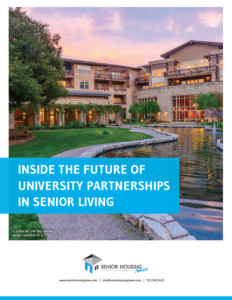One non-profit developer and provider of continuing care retirement communities (CCRCs) is hoping to entice more aging baby boomers to move into senior housing by sending them back to school. The idea has uncorked a torrent of demand, leading to the fastest-selling community the provider has ever built.
Medford, Oregon-based Pacific Retirement Services (PRS) last month closed on a $250 million bond for the construction of Mirabella at ASU, a 20-story life plan community located on Arizona State University’s main campus in Tempe, Arizona. PRS has 10 life plan communities in its portfolio, plus three that it manages.
As planned, the 620,000-square-foot entry-fee community will have 304 units across the continuum of care, with apartment and penthouse dwellings that range from 751 square feet to 2,665 square feet in size. Amenities include four dining venues—three of which are located on the penthouse level—an indoor pool and wellness center, an event center, a library and underground parking.
Ankrom Moissan Architects is the architect for the community, with McCarthy Construction Company slated to build it.
The development is the third entry in the nonprofit’s urban CCRC concept called Mirabella, which is focused on spacious, upscale living. Monthly rents will hover around $4,000 to $5,000, with buy-ins for residents ranging between about $300,000 to around $1.8 million—price tags similar to what you might find in an upscale downtown condominium building, said Brian McLemore, CEO and president of PRS.
“We’ve found in these highrise urban models, to get people out of a home in the suburbs and into a walkable downtown lifestyle, we can’t build units that are too small,” McLemore told Senior Housing News. “We’ve gone up to bigger units.”
University appeal
Spacious layouts and luxurious amenities aren’t the community’s only selling points, however. Mirabella at ASU also comes with a host of university-specific perks geared toward seniors and made possible through a proposed partnership with Arizona State University.
For instance, each resident of Mirabella at ASU will get a student ID card, which will let them sit in on ASU classes, attend university lectures and browse the university’s library system. The community will also have a university event space, an art gallery and regular performances from ASU School of Music students in the dining venues.
Though PRS has worked with universities before, this is the first time it’s worked with one so closely—and that has worked out very much to the nonprofit’s benefit. Similarly, many other senior living providers have found success in the university-based retirement community, or “URBC” concept.
“The concept of taking a high-end urban highrise and plopping it on an active college campus is attractive to folks,” McLemore said. “We’ve collected, in three months, [more than] 170 10% deposits, which is the fastest-selling one we’ve ever seen in our work, and I’ve done this for 30 years.”
The community could sell out as early as spring of this year, a full two years before construction is scheduled to wrap up, he added.
Keeping up with the times
Mirabella at ASU’s university focus is part of PRS’ overall push to keep its communities up-to-date with the latest trends.
The nonprofit invests $30 million to $40 million per year in repositioning its existing properties to keep them appealing to prospective residents. Those repositioning projects have helped keep all of the provider’s communities above 90% occupancy, with both Mirabella CCRCs running close to full with long waitlists, McLemore said.
PRS also has four expansion projects totaling over $100 million in the works in California and Oregon.
“We’re constantly having our ear to the ground on what our customers are going to demand from us in the future,” McLemore added.
And with economic tailwinds at non-profit CCRC providers’ backs, PRS feels that now is the right time to invest in expansion and development projects.
“Because of the cost and scope of these life plan communities, not a lot of them have been built over the last seven or eight years,” McLemore said. “We see lots of pent-up demand.”
Want to learn more about partnerships between senior living providers and universities? Check out the new Senior Housing News report “Inside The Future of University Partnerships in Senior Living.”
Click here to access the complete report, which takes a deep dive into the topic of university partnerships in senior living—from the successes to the failures—and reveals why creating strong ties with a university is one of the smartest moves a senior housing provider can make.
Written by Tim Regan
Companies featured in this article:
Ankrom Moissan Architects, McCarthy Construction Company, Pacific Retirement Services Inc.



